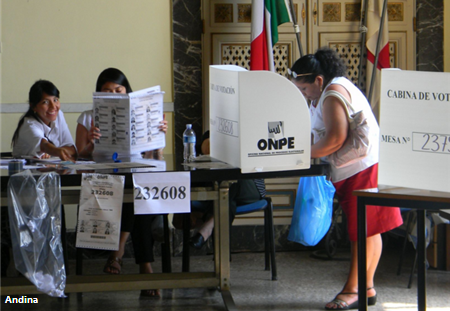By Nicholas Asheshov ✐
 According to the national elections board, ONPE, the number of voters this Sunday, June 5, should officially be more than 22 million, a sharp increase over earlier elections. But our numbers are also changing shape, not only in the totals.
According to the national elections board, ONPE, the number of voters this Sunday, June 5, should officially be more than 22 million, a sharp increase over earlier elections. But our numbers are also changing shape, not only in the totals.
Richard Webb, Peru’s leading economist and former executive chairman of the Central Bank, says that according to the United Nations —which uses a kind of statistical speedometer— on May 23, Monday last week, Peruvians totaled 31,747,710.
In the old days of the 20th century, half of Peru’s population would be non-voters, under the age of 18. If that proportion had continued, the number of voters this coming Sunday would be only a bit above 15 million, well short of today’s reality of 22mn!
“What has happened is that life expectancy has increased {by 15 years},” according to Alfredo Torres, political scientist and head of the leading polling company IPSOS. “And so now there are more adults than children. Maybe you remember that at one time the average age of Peruvians was 20. Now it is 30. That is why Peru’s current population is estimated at (almost) 32 million, and the voting population at 22 million. There are around 10 million minors.”
“The Peruvian population by ages is no longer shaped like a pyramid but like a bottle, and we are beginning to live in what is known as the “demographic bonus,” a time when the larger part of the population is of working age,” adds Torres. “There are less children but there are still few old people.”
Richard Web adds: “We’re growing by 505 persons per day, after netting 782 births minus 216 deaths and 61 emigrants.” (UN statistics.)
As background, in 1500 the population of the Inca Empire was 10mn, give or take, according to the demographer Noble David Cook. Prof. William Denevan, the U. of Wisconsin geographer —also a Peruvian Times reporter in the 1950s— calculates there were at the same time, an additional 10mn living in the neo-tropics of the Amazon, including naturally Brazil, Colombia, Ecuador and Bolivia, as well as our own Amazon.
But the Conquista, beginning in 1532 with “Los Pizarro”, set off one of the great population collapses of modern history. A census carried out by the Spanish Viceroy in 1603 found only a handful more than one million people, including the tribes in the jungle.
To put this in context, the population of England was just 5mn at that time. Today, the United Kingdom has a population of 60mn, the same figure as for the Roman Empire when Jesus Christ was born.
Peru’s population increased slowly during the Colonial and the first half of the Republican eras. By 1900 it had reached a total of only 3mn, according to the 11th Edition (1911) of the Encyclopedia Britannica. This is, of course, one-tenth of today’s figure.
By 1960 Peru had increased to 11mn, of which a bit more than 4mn were voters. One million of the population lived in Lima. Of the 11mn, half were rural. The Inca population at 10mn was all rural, meaning that the rural agricultural population of Peru under the Incas was twice the rural population in the middle of the 20th century. It was only by the turn of the 21st century that the rural population had caught up with its equivalent in 1500. It has grown steadily over the past half-century, although it has fallen as a percentage of the total — i.e. the urban population has been growing faster than the population of the countryside.
However, the past couple of decades has seen a reversal, quite a sharp one, in relative growth rates. Today Lima and the main coastal cities like Piura, Trujillo, Chimbote and Arequipa, have been growing at just 2 percent. This is in contrast to the four-to-five percent growth of the smaller provincial capitals in the Sierra and Selva.
This has come together, by no coincidence, with a quantum leap this century in income and investment levels beyond Lima. Poverty has dropped dramatically. As Richard Webb describes in “Conexión y despegue rural,” published by the Instituto del Perú, this is related directly to the proliferation of mobile phones, the internet and more roads and electricity.
Nick Asheshov was editor of the Andean Air Mail & Peruvian Times during the 1970s and 1980s, and of The South Pacific Mail, Santiago during the 1990s. He was Latin America Editor of Institutional Investor, New York over the same period. He lives in Urubamba, where he writes a blog and where he has been prominent in the hotel and railway business.





